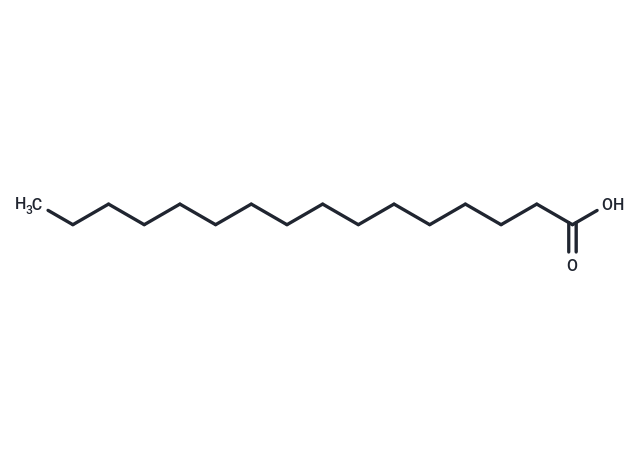Shopping Cart
- Remove All
 Your shopping cart is currently empty
Your shopping cart is currently empty

Palmitic acid (Cetylic acid) is a natural product, a common saturated fatty acid found in animals, plants and microorganisms. Palmitic acid has antitumor activity.

| Pack Size | Price | Availability | Quantity |
|---|---|---|---|
| 5 g | $48 | In Stock | |
| 10 g | $65 | In Stock |
| Description | Palmitic acid (Cetylic acid) is a natural product, a common saturated fatty acid found in animals, plants and microorganisms. Palmitic acid has antitumor activity. |
| In vitro | METHODS: Mouse microglia BV2 were treated with Palmitic acid (25-200 nM) for 6-48 h, and cell viability was measured by MTT. RESULTS: Palmitic acid had concentration- and time-dependent inhibitory effects on microglia viability. [1] METHODS: Monocyte-derived dendritic cells MoDC were treated with Palmitic acid (150 μM) for 12 h. The expression of DC co-stimulatory factors was measured by Flow Cytometry. RESULTS: Palmitic acid induced the expression of CD86 and CD83, indicating that the activation and maturation of MoDC were induced simultaneously. [2] |
| In vivo | METHODS: To investigate the effects on adverse biological behaviors in mice, Palmitic acid (0.3-30 μmol/mouse in castor oil) was administered as a single intraperitoneal injection to C57BL/6J mice, and biological behaviors were analyzed 2-24 h later. RESULTS: In a dose-dependent manner, Palmitic acid rapidly reduced locomotor activity in mice through a mechanism dependent on fatty acid chain length. 24 h after Palmitic acid administration, mice exhibited anxiety-like behaviors, whereas there was no impairment of locomotion, food intake, depression-like behaviors, or spatial memory. [3] METHODS: To investigate the effects on myocardial injury, Palmitic acid (5 mM in 500 μL solution) was injected intravenously into the tail of wild-type C57BL/6 (B6) and Md2-/- (KO) mice once a day for seven days. RESULTS: Palmitic acid induced myocardial inflammatory injury via TLR4 accessory protein MD2 and protected Md2 knockout mice from myocardial injury induced by Palmitic acid and high-fat diet. [4] |
| Kinase Assay | As sources of PLA2, human recombinant sPLA2 (type IIA) is purified from CHO cells transfected with the PLA2 gene and rabbit recombinant platelet cPLA2 is obtained through its expression in baculovirus. The standard reaction mixture (200 μL) contained 100 mM Tris-HCl buffer (pH 9.0) with 6 mM CaCl2 and 20 nmol 1-acyl-[1-14C]-arachidonyl-sn-glycerophosphoethanolamine (2000 cpm/nmol) in the presence or absence of Tanshinone I. The reaction is started by adding 50 ng purified sPLA2 or cPLA2. After 20 min at 37°C, the free fatty acid generated is analysed. Under these standard conditions, the reaction mixture in the absence of Tanshinone I released approximately 10% of free fatty acid from the phospholipid substrate added[1]. |
| Alias | Hexadecoic acid, hexadecanoic acid, Cetylic acid |
| Molecular Weight | 256.42 |
| Formula | C16H32O2 |
| Cas No. | 57-10-3 |
| Smiles | C(CCCCCCCCCC)CCCCC(O)=O |
| Relative Density. | 0.852 g/cm3 at 25℃ (lit.) |
| Storage | Powder: -20°C for 3 years | In solvent: -80°C for 1 year | Shipping with blue ice. | |||||||||||||||||||||||||||||||||||
| Solubility Information | DMSO: 2.56 mg/mL (9.98 mM), Sonication is recommended. Ethanol: 27.78 mg/mL (108.33 mM), Sonication is recommended. 10% DMSO+40% PEG300+5% Tween 80+45% Saline: 0.26 mg/mL (1.01 mM), In vivo: Please add the solvents sequentially, clarifying the solution as much as possible before adding the next one. Dissolve by heating and/or sonication if necessary. Working solution is recommended to be prepared and used immediately. | |||||||||||||||||||||||||||||||||||
Solution Preparation Table | ||||||||||||||||||||||||||||||||||||
DMSO/Ethanol
Ethanol
| ||||||||||||||||||||||||||||||||||||

Copyright © 2015-2025 TargetMol Chemicals Inc. All Rights Reserved.